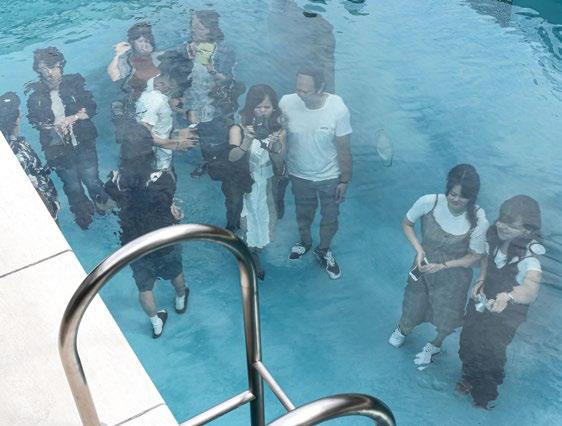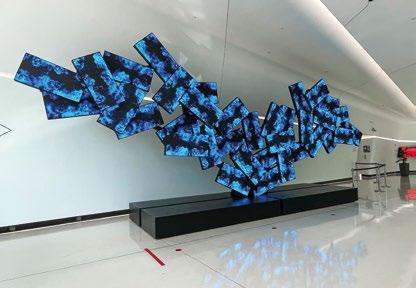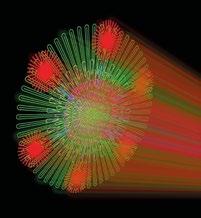
6 minute read
Augmented Unreality
Augmented Unreality
Existing somewhere between reality and representation, art has been defined as a "lie that brings us closer to the truth". Not a lie, but a means of interpreting what exists and offering a different view of reality, in which technology can play a part.
THE EDITORIAL OFFICE
"Who would dare to pretend that the image of a pipe is a pipe? Who could smoke the pipe in my painting? No-one. So it's not a pipe." René Magritte himself explained the meaning of one of his most famous works, “La Trahison des Images" or "Ceci n'est pas une pipe", to underline the dichotomy between an object and its representation. There was no indissoluble link, such as classical painting demanded, between image and reality.
The art world has seen a growing variety of techniques and media that have influenced reflection on reality
Since 1929, when the controversial pipe was painted, the art world has seen a growing variety of techniques and media that have guided and in some way also influenced reflection on reality and the way it is perceived. To take a recent example, this is true of the visual enchantments of the Argentine artist Leandro Erlich, who uses installations, sculptures, videos, sounds and photographs to create alternative realities that are more than plausible but clearly fictitious - alternatives to what we understand as "real". Nothing is what it seems and everything is illusion.

SCREEN-BASED ART
Technological development has allowed artists to experiment with a growing number of forms and tools of expression to explore creative possibilities and offer various, sometimes alternative, visions of reality. This happened in the nineteenth century with photography and in the following century with cinema. It is unsurprising that this process continues with computers and artificial intelligence.
Video art, designed for the screen, is part of this process, using video as a creative tool to tell stories and record reality, and also to investigate the potential of new means of expression. Fascinating experiments have been conducted by Nam June Paik of Korea, the first person to transform the television into an object of art, for example by distorting the signal with a magnet to produce modified images and sounds. Another example was set by Wolf Vostell of Germany, who placed televisions, showing distorted images, in ramshackle settings and often destroyed them during performances that themselves constituted the works of art.

Video art also includes the works of the American Bill Viola, internationally considered the undisputed master of this art form. Working with electronic music, experimental films and the potential of performance art, Viola constantly performs research on people and their relationship with the environment, often through slow-motion images projected in historical and evocative settings, with spectators invited to immerse themselves in live artworks. Or again, the works of the Swiss video artist Pipilotti Rist, the nom de plume of Elisabeth Charlotte Rist, who uses video to study popular culture and the role of women in society. Synthetic images and virtual spaces are now the frontiers of computer art and text-to-image systems that generate original images from textual descriptions. Such tools allow the user to interact with art works and modify them, both as a viewer and a creator.
Technological development has allowed artists to experiment with creative possibilities and offer different visions of reality
All things considered, we are heading rapidly towards a world in which digital is unequivocally superimposed on physical reality. It is a trend that affects both the artist and the interaction between the work and the viewer, who increasingly becomes an active part of the work itself, transforming the traditional experience of art gallery visits. Once again, everything seems set to change the way we interpret reality and interact with the world around us.
THE HUNGRIEST EYE. THE SPECTATOR'S GAZE AND THE TECHNOLOGY THAT REVEALS EVERYONE'S UNIQUENESS
The relationship between art and spectator, projection into reality, the analysis and sharing of experience as a hallmark of contemporary art. In the home of The Human Safety Net at the Procuratie Vecchie IN Venice's St. Mark's Square, there is an installation that embodies this spirit and reveals everyone's uniqueness through the language of art. To do so it uses unique and ephemeral forms that combine with others in surprising ways. It is “The Hungriest Eye. The Blossoming of Potential” by the artist Arthur Duff, welcoming visitors to the Art Studio, the space where art dialogues with society, curated by art historian and critic Luca Massimo Barbero.
An installation that reveals everyone's uniqueness through the language of art
Inauguration of “The Hungriest Eye” in April 2023 marked the first year of The Human Safety Net at the Procuratie Vecchie. This building of exceptional historical and monumental importance, restored thanks to a project by David Chipperfield Architects Milan, welcomed over 60,000 visitors and hosted over 100 events in its first year of opening. Duff's installation integrates and completes the journey of the permanent exhibition "A World of Potential", an interactive and immersive experience that helps people to understand and connect with their potential, and to explore the strengths and discover the best qualities of themselves and others. It also features stories about the beneficiaries, operators and volunteers of Generali's The Human Safety Net Foundation. The work allows visitors to see their strengths transformed into artistic representation by means of a laser system that creates unique shapes in a kaleidoscope of lights. Its inspiration comes from nineteenth-century Japanese woodcuts depicting fireworks, emblematic of an ideal of ephemeral and transitory beauty designed to amaze and surprise the eye of the beholder - the "hungry" eye (hence the title of the work) that aims to channel a perceptive stimulus and participate in processing the experience. An experience that is both individual and collective, because new light compositions are created as new visitors arrive. Everyone is thus unconsciously led to join others in an experiment with interactive dynamics, the sharing of a space and an experience, and the freedom to express oneself in interaction.

Visitors can repeat the experience several times and witness the formation of an ever-changing image. Every experience exists in a different way, and this is expressed by the infinite variety of forms that unfold before the "hungry eye": reflections and plays of light in art that is performed rather than viewed, in an expression of individual potential and personal uniqueness.










